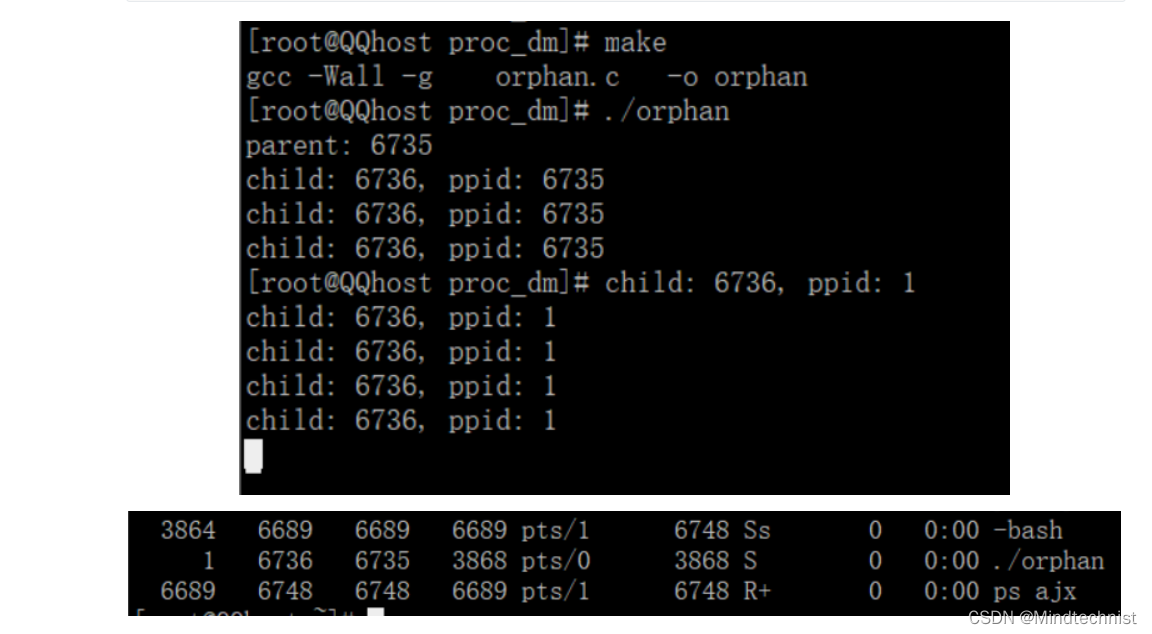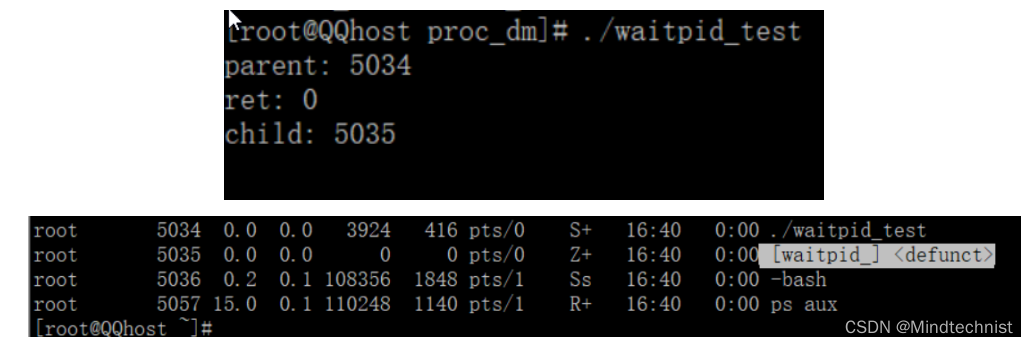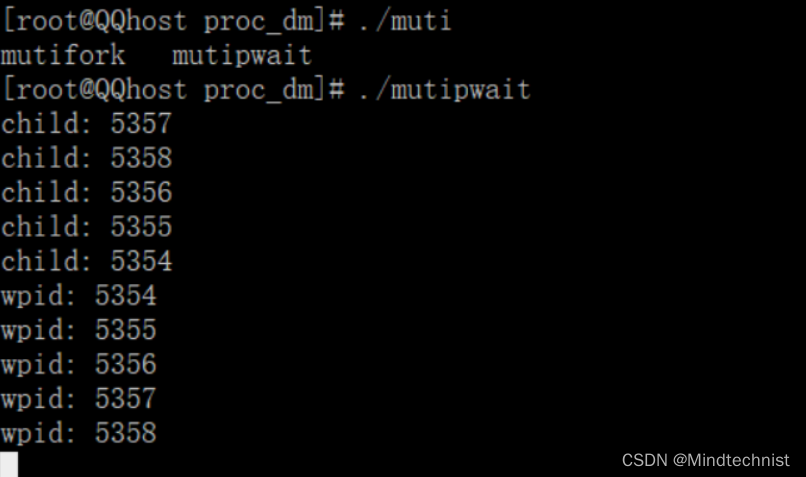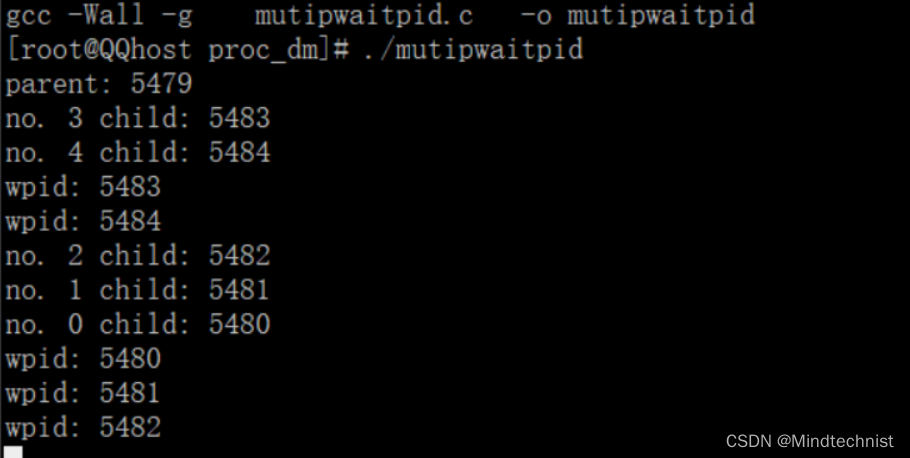17.进程回收
1.为什么要进行进程资源的回收
当一个进程退出之后,进程能够回收自己的用户区的资源,但是不能回收内核空间的PCB资源,必须由它的父进程调用wait或者waitpid函数完成对子进程的回收,避免造成系统资源的浪费。
2.孤儿进程
- 孤儿进程的概念:
若子进程的父进程已经死掉,而子进程还存活着,这个进程就成了孤儿进程。
-
为了保证每个进程都有一个父进程,孤儿进程会被init进程领养,init进程成为了孤儿进程的养父进程,当孤儿进程退出之后,由init进程完成对孤儿进程的回收。
-
模拟孤儿进程的案例
编写模拟孤儿进程的代码讲解孤儿进程,验证孤儿进程的父进程是否由原来的父进程变成了init进程。
测试1: 孤儿进程测试
/************************************************************
>File Name : orphan.c
>Author : Mindtechnist
>Company : Mindtechnist
>Create Time: 2022年05月19日 星期四 20时53分41秒
************************************************************/
#include <stdio.h>
#include <stdlib.h>
#include <unistd.h>
int main(int argc, char* argv[])
{
pid_t pid = fork();
if(pid == 0)
{
while(1)
{
printf("child: %d, ppid: %d\n", getpid(), getppid());
sleep(1);
}
}
if(pid > 0)
{
printf("parent: %d\n", getpid());
sleep(3);
}
return 0;
}

我们看到,子进程的父进程ID在3秒后变成了1,这说明父进程结束后,它变成了孤儿进程,并被init进程收养,使用kill命令基于可以杀死孤儿进程。
3.僵尸进程
- 僵尸进程的概念:
若子进程死了,父进程还活着,但是父进程没有调用wait或waitpid函数完成对子进程的回收,则该子进程就成了僵尸进程。
- 如何解决僵尸进程
▶由于僵尸进程是一个已经死亡的进程,所以不能使用kill命令将其杀死
▶通过杀死其父进程的方法可以消除僵尸进程。杀死其父进程后,这个僵尸进程会被init进程领养,由init进程完成对僵尸进程的回收。
- 模拟僵尸进程的案例
编写模拟僵尸进程的代码讲解僵尸进程,验证若子进程先于父进程退出,而父进程没有调用wait或者waitpid函数进行回收,从而使子进程成为了僵尸进程。
测试2: 僵尸进程测试
/************************************************************
>File Name : zombie.c
>Author : Mindtechnist
>Company : Mindtechnist
>Create Time: 2022年05月19日 星期四 20时54分20秒
************************************************************/
#include <stdio.h>
#include <stdlib.h>
#include <unistd.h>
int main(int argc, char* argv[])
{
pid_t pid = fork();
if(pid == 0)
{
printf("child: %d, ppid: %d\n", getpid(), getppid());
sleep(1);
}
if(pid > 0)
{
while(1)
{
printf("parent: %d\n", getpid());
sleep(1);
}
}
return 0;
}
我们可以通过ps命令查看僵尸进程

图中红色标出的三个地方Z+、[]、default都可以表明这是僵尸进程,另外Z+是进程类型的一个表示,可以通过 man ps 查看,我们可以通过 man ps 进入帮助手册,然后在命令行输入 /zombie 来搜索zombie相关的信息。

僵尸进程是不能用kill杀死的,因为kill命令是终止进程,而僵尸进程已经终止了。我们知道僵尸进程的资源需要由父进程去回收,那么我们在这种情况下如何回收僵尸进程的资源呢?方法就是杀死父进程,父进程被杀死后,由init接管子进程并回收子进程资源。

4.进程回收函数
4.1wait()函数
▶函数原型:
pid_t wait(int *status);
▶函数作用:
▷阻塞并等待子进程退出
▷回收子进程残留资源
▷获取子进程结束状态(退出原因)。
▶返回值:
▷成功:清理掉的子进程ID;
▷失败:-1 (没有子进程)
▶status参数:子进程的退出状态 -- 传出参数
▷WIFEXITED(status):为非0 → 进程正常结束
WEXITSTATUS(status):获取进程退出状态
▷WIFSIGNALED(status):为非0 → 进程异常终止
WTERMSIG(status):取得进程终止的信号编号。
一个进程在终止的时候会关闭所有的文件描述符,释放在用户空间分配的内存,但是它的PID还保留着,内核在其中保存了一些信息:如果进程是正常终止则保存进程退出状态;如果进程是异常终止,则保存导致该进程终止的那个信号。这个进程的父进程可以调用wait()或者waitpid()来获取这些信息,然后彻底清除这个进程。我们知道,一个进程的退出状态可以在shell中用特殊变量$?查看,因为shell进程是它的父进程,当它终止的时候shell调用wait()或waitpid()得到它的退出状态,同时彻底清除这个进程。父进程调用wait()函数可以回收子进程终止信息,wait()函数功能主要有三个:阻塞等待子进程退出;回收子进程残留资源;获取子进程退出状态(退出原因)。
4.1.1包含头文件及函数原型
#include <sys/types.h>
#include <sys/wait.h>
pid_t wait(int *status);
/*
pid_t waitpid(pid_t pid, int *status, int options);
int waitid(idtype_t idtype, id_t id, siginfo_t *infop, int options);
*/
4.1.2函数描述
wait()函数用于回收子进程,获取子进程的终止原因,如果子进程没有终止,那么将会阻塞等待子进程的终止。
4.1.3函数参数
- status:传出参数(C语言一级指针做输出)
WIFEXITED(status) /*wait if exited 等待是否退出*/
WEXITSTATUS(status) /*wait exit status 退出原因*/
WIFSIGNALED(status) /*wait if signaled 是否被信号杀死*/
WTERMSIG(status) /*wait term sugnaled 被几号信号杀死的*/
WCOREDUMP(status)
WIFSTOPPED(status)
WSTOPSIG(status)
WIFCONTINUED(status)
- 根据status判断子进程终止原因
WIFEXITED(status)判断子进程是否正常退出;
WIFEXITED(status)为真表示正常退出,使用WEXITSTATUS(status)获取退出状态;
WIFEXITED(status)非真,表示非正常退出,使用WIFSIGNALED(status)判断是否被信号杀死;
WIFSIGNALED(status)为真,表示是被信号杀死,使用WTERMSIG(status) 获取杀死进程的信号;
4.1.4函数返回值
- on success, returns the process ID of the terminated child; wait()函数成功返回终止的子进程的ID.
- on error, -1 is returned. 失败返回-1.
案例测试: wait()获取子进程退出原因
/************************************************************
>File Name : wait_test.c
>Author : Mindtechnist
>Company : Mindtechnist
>Create Time: 2022年05月19日 星期四 22时45分28秒
************************************************************/
#include <stdio.h>
#include <stdlib.h>
#include <unistd.h>
#include <sys/types.h>
#include <sys/wait.h>
int main(int argc, char* argv[])
{
pid_t pid = fork();
if(pid == 0)
{
printf("child: %d, ppid: %d\n", getpid(), getppid());
sleep(3); /*子进程睡眠3秒,那么父进程中的wait函数会阻塞3秒,一直等到子进程退出*/
return 66; /*正常退出,这个值可以被WEXITSTATUS获取到,这个值是有范围的*/
/*exit(66); 也表示正常退出*/
}
if(pid > 0)
{
int status;
pid_t wpid = wait(&status);
printf("wpid: %d, cpid: %d\n", wpid, pid);
if(WIFEXITED(status)) /*进程正常退出,获取退出原因*/
{
printf("child exit because: %d\n", WEXITSTATUS(status));
}
else /*非正常退出*/
{
if(WIFSIGNALED(status)) /*为真表示被信号杀死*/
{
printf("signal is: %d", WTERMSIG(status));
}
else
{
printf("other...\n");
}
}
while(1)
{
sleep(3);
}
}
return 0;
}
我们首先演示一下子进程的正常退出,并获取退出状态,子进程的退出状态可以用return或者exit来传递。

在代码中,当 fork() 被调用时,它创建了一个子进程,这个子进程是父进程的副本。然后,两个进程(父进程和子进程)从 fork() 的返回位置开始并行执行。由于它们是并发执行的,理论上,父进程和子进程的代码都有机会首先运行。
然而,通常情况下,我们会看到子进程的输出先于父进程的输出,有以下几个原因:
-
调度器决策:操作系统的调度器可能决定让新创建的子进程先运行,尤其是当系统资源充足,且没有其他高优先级的任务时。
-
输出缓冲:
printf函数通常使用缓冲输出。这意味着即使父进程或子进程先执行其printf语句,输出可能不会立即显示在屏幕上或写入文件中。子进程在printf之后进入sleep状态,这可能导致其输出被刷新到屏幕上。而父进程在其printf之后立即调用了wait(),可能在子进程结束之前都不会刷新其输出缓冲区。 -
运行环境的影响:具体哪个进程先输出还取决于运行环境、系统的当前负载、其他运行中的进程和线程以及其他一些因素。
虽然在许多情况下,子进程的输出可能会先于父进程显示,但这并不是一个固定的规则。如果多次运行同一段代码,可能会看到不同的顺序,尤其是在高负载的系统或具有多个CPU核心的系统上。因此,除非有明确的同步机制,否则不能保证并发进程的执行顺序。
下面我们在子进程中增加一个循环,然后用信号杀死子进程
if (pid == 0)
{
printf("child: %d, ppid: %d\n", getpid(), getppid());
sleep(2); /*子进程睡眠3秒,那么父进程中的wait函数会阻塞3秒,一直等到子进程退出*/
while (1)
{
printf("child: %d, ppid: %d\n", getpid(), getppid());
sleep(1);
}
}
重新编译运行,并开启另一个shell,使用 kill -9 杀死子进程

获取到杀死进程的信号,正好是9号信号,如果直接使用 kill pid 默认使用的是15号信号。

4.2waitpid()函数
- waitpid函数
▶函数原型:
pid_t waitpid(pid_t pid, int *status, in options);
▶函数作用
同wait函数
▶函数参数
参数:
pid:
pid = -1 等待任一子进程。与wait等效。
pid > 0 等待其进程ID与pid相等的子进程。
pid = 0 等待进程组ID与目前进程相同的任何子进程,也就是说任何和调用waitpid()函数的进程在同一个进程组的进程。
pid < -1 等待其组ID等于pid的绝对值的任一子进程。(适用于子进程在其他组的情况)
status: 子进程的退出状态,用法同wait函数。
options:设置为WNOHANG,函数非阻塞,设置为0,函数阻塞。
▶函数返回值
>0:返回回收掉的子进程ID;
-1:无子进程
=0:参3为WNOHANG,且子进程正在运行。
- waitpid函数练习
使用waitpid函数完成对子进程的回收
4.2.1包含头文件及函数原型
#include <sys/types.h>
#include <sys/wait.h>
pid_t waitpid(pid_t pid, int *status, int options);
4.2.2函数描述
The waitpid() system call suspends execution of the calling process until a child specified by pid argument has changed state.
waitpid() 系统调用暂停调用进程的执行,直到由 pid 参数指定的子进程改变了状态。
4.2.3函数参数
- pid:
■小于 -1:meaning wait for any child process whose process group ID is equal to the absolute value of pid. 回收一个组的子进程,使用时把组ID(一般是父进程ID)传给pid参数,就可以使用waitpid()回收这个进程组的所有子进程。
■-1:meaning wait for any child process. 回收所有,任何子进程,这是最常用的取值,把所有子进程都回收。
■0:meaning wait for any child process whose process group ID is equal to that of the calling process. 回收和调用进程组ID相同的组内的子进程。
■大于0:meaning wait for the child whose process ID is equal to the value of pid. 回收指定的进程pid。
- status:传出参数,同wait()函数
- options:选项
■WNOHANG: return immediately if no child has exited. wait no hang,如果子进程没有结束,立即返回,不会挂起等待(wait函数如果子进程没有退出会阻塞等待)。如果options参数填0,那么和wait()函数一样会挂起等待子进程结束。
■WUNTRACED: also return if a child has stopped (but not traced via ptrace(2)). Status for traced children which have stopped is provided even if this option is not specified.如果子进程已停止(但未通过 ptrace(2) 进行跟踪)则返回。即使没有指定此选项,仍会提供已停止的被跟踪子进程的状态。
■WCONTINUED: also return if a stopped child has been resumed by delivery of SIGCONT.如果一个已停止的子进程因接收到 SIGCONT 信号而恢复,则返回。
- 函数返回值
■on success, returns the process ID of the child whose state has changed; if WNOHANG was specified and one or more child(ren) specified by pid exist, but have not yet changed state, then 0 is returned. 如果设置了WNOHANG选项,并且没有子进程退出则返回0,如果有子进程退出则返回退出子进程的pid。
■On error, -1 is returned. 比如说没有子进程或子进程早就全部结束了,可能就会出错返回-1。
下面通过例子演示waitpid()函数的用法。
/************************************************************
>File Name : waitpid_test.c
>Author : Mindtechnist
>Company : Mindtechnist
>Create Time: 2022年05月20日 星期五 16时31分35秒
************************************************************/
#include <stdio.h>
#include <stdlib.h>
#include <unistd.h>
#include <sys/types.h>
#include <sys/wait.h>
int main(int argc, char* argv[])
{
pid_t pid = fork();
if(pid == 0)
{
printf("child: %d\n", getpid());
sleep(2);
}
if(pid > 0)
{
printf("parent: %d\n", getpid());
int ret = waitpid(-1, NULL, WNOHANG);
printf("ret: %d\n", ret);
while(1)
{
sleep(1);
}
}
return 0;
}

为什么使用了waitpid()函数还会产生僵尸进程呢,这是因为在waitpid()函数中使用了选项参数WNOHANG,而子进程中有一个睡眠函数,子进程睡眠的时候,父进程中waitpid()语句没有等到子进程结束就执行了,由于WNOHANG选项参数的存在,waitpid不会阻塞等待之进程结束,而是直接返回。当waitpid()返回父进程中后,子进程才结束,但是waitpid()已经执行完了,所以并没有回收子进程,子进程因此变成僵尸进程。
解决方法就是在一个循环中执行waitpid()函数,直到ret不等于0的时候说明子进程退出了,跳出循环。
5.回收多个子进程
上面使用wait()函数和waitpid()函数举的例子都是回收一个子进程,有时候我们可能需要回收多个子进程,下面介绍回收多个子进程的方法。
5.1 使用wait()回收多个子进程
首先使用wait()函数来回收多个子进程,我们可以在一个for循环中等待子进程的结束,创建了几个子进程就for循环等待几次,代码如下。
/************************************************************
>File Name : mutipwait.c
>Author : Mindtechnist
>Company : Mindtechnist
>Create Time: 2022年05月20日 星期五 17时23分57秒
************************************************************/
#include <stdio.h>
#include <stdlib.h>
#include <unistd.h>
#include <sys/types.h>
#include <sys/wait.h>
int main(int argc, char* argv[])
{
int i = 0;
pid_t pid;
for(i = 0; i < 5; i++)
{
pid = fork();
if(pid == 0)
{
printf("child: %d\n", getpid());
break;
}
}
sleep(i);
if(i == 5) /*只有父进程可以执行到i=5*/
{
for(i = 0; i < 5; i++)
{
pid_t wpid = wait(NULL);
printf("wpid: %d\n", wpid);
}
while(1)
{
sleep(1);
}
}
return 0;
}
编译运行,可以看到所有子进程都被回收。

5.2使用waitpid()回收多个子进程
如果使用waitpid()函数,可以借助函数的参数和返回值去判断每个子进程是否回收成功。
/************************************************************
>File Name : mutipwaitpid.c
>Author : Mindtechnist
>Company : Mindtechnist
>Create Time: 2022年05月20日 星期五 17时45分39秒
************************************************************/
#include <stdio.h>
#include <stdlib.h>
#include <unistd.h>
#include <sys/types.h>
#include <sys/wait.h>
int main(int argc, char* argv[])
{
int i = 0;
pid_t pid;
for(i = 0; i < 5; i++)
{
pid = fork();
if(pid == 0)
{
break;
}
}
if(i == 5) /*只有父进程可以执行到i=5*/
{
printf("parent: %d\n", getpid());
while(1) /*无限循环保证所有子进程全部回收*/
{
pid_t wpid = waitpid(-1/*回收任何子进程*/, NULL, WNOHANG);
if(wpid == -1)
{
break; /*如果返回-1说明已经没有子进程了,退出循环*/
}
if(wpid > 0)
{
printf("wpid: %d\n", wpid); /*打印被回收的子进程的ID*/
}
}
while(1)
{
sleep(1);
}
}
if(i < 5) /*说明是子进程*/
{
printf("no. %d child: %d\n", i, getpid());
}
return 0;
}
编译执行,可以看到所有进程都被回收了

参考: